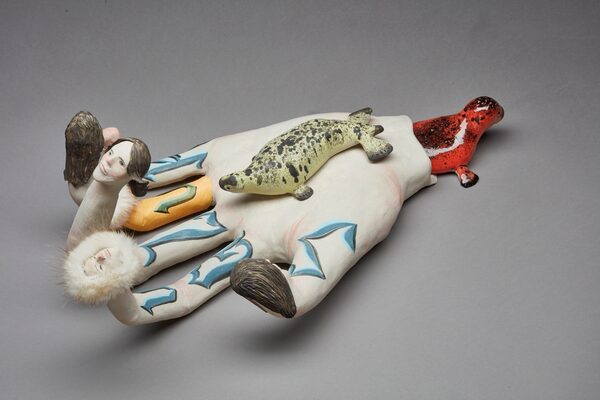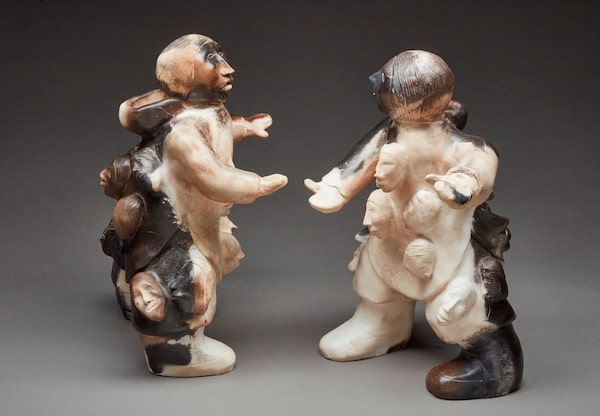
Shuvinai Ashoona & Shary Boyle, Universal Cobra Pussy, 2011, ink, gouache and coloured pencil on paper, 111.8 x 111.8 cm. Private collection.Toni Hafkenscheid
“More and more I feel like art has to have some function for the community outside of the art world,” says Shary Boyle, who has a position in the art world that many of her peers might envy. The Toronto-based artist was Canada’s representative at the Venice Biennale in 2013, and her work is in several major Canadian museums. Her first large-scale public-art commission will be installed this summer in front of Toronto’s Gardiner Museum.
Having a place in that world can mean being absorbed into a historical and professional system that assigns an exalted status to art, secretes a learned discourse about it and tends to hive it away from ordinary life. All of that goes against the grain for Boyle, who grew up in a working-class household and cares about social issues.
“We’re really in trouble, and it’s hard to separate myself from that and just make art for museums,” she says. “Meeting people that are also outside of that realm, and working in art, widens the parameters of what art can do for people.”

Shuvinai Ashoona & Shary Boyle, Black Marble, 2015, ink and coloured pencil on paper, 91.4 x 106.7 cm. Collection Lune Rouge.Paul Litherland
That was part of the appeal, for her, of co-curating an exhibition for Calgary’s Esker Foundation that presents her work with that of artists from northern Inuit communities, where art-making has different traditions and social functions than it does in the south. Another draw was the shock of recognition Boyle felt when she first encountered the art of Shuvinai Ashoona, from Kinngait (Cape Dorset).
“It was like an immediate explosion for me,” Boyle says of the moment in 2009 when curator Nancy Campbell first put the two women’s drawings together at a show at the University of Toronto’s Justina M. Barnicke Gallery. “I felt a deep kinship with her work.”
You can see the imaginative affinity in Earthlings, the Esker show now on view at the Galerie de l’UQAM in Montreal. Ashoona and Boyle both inhabit a figurative and fantastical world, where beings freely mutate and participate in visual narratives that often look like scenes from creation mythology.

Shary Boyle & John Kurok, Sugluk, 2016, porcelain, 20 x 46 x 30 cm. Private collection.Rafael Goldchain
Boyle also found less-visible points of connection with Ashoona, and with five ceramic artists working out of the Matchbox Gallery in Kangiqliniq (Rankin Inlet), whose figurative pots she and co-curator Shauna Thompson also included in Earthlings. Boyle’s Inuit collaborators – with whom she produced several pieces jointly – all learned their craft in apprenticeship situations, as Boyle did when she began working in porcelain, which she learned “through basement hobby groups with old ladies.” The northerners don’t have a curatorial strategy behind what they make, she says, and don’t gravitate toward art-history concepts as taught in art schools.
“Their work isn’t based in Western principles and the English language. It’s very sincere, and it’s about the sovereignty of the visual imagination,” she says.
When she first went up north to work in a community studio with Ashoona, she says, she was moved by the silence and autonomy that surrounded each person’s art practice.

Pierre Aupilardjuk, Friends Sharing Gossip, n.d., smoke-fired stoneware, 40 x 28 x 26 cm. Private collection.M.N. Hutchinson
“For me, it reinforced a sense of independence from the art world, into a larger world community,” Boyle says. “I want my work to be useful, more than an intellectual or status pursuit.”
She realized that bringing Ashoona and the Matchbox ceramicists (Pierre Aupilardjuk, Jessie Kenalogak, John Kurok, Leo Napayok and the late Roger Aksadjuak) to the Esker Foundation, and the other stops on the exhibition tour, could be directly useful to them as northerners who depend on their art to make a living. They would gain access to different venues and economic situations, beyond the usual system of Inuit artists showing in Inuit galleries, and of often being received, as Boyle says, “more as ‘folk art’ than ‘educated art.’”
Earthlings also faithfully portrays the real differences between Boyle and her northern collaborators. Monstrous as some of Ashoona’s depicted beings can be, they seem to inhabit a world that is essentially harmonious. In one of her drawings, a human family and several animals float in space, holding hands with each other and the Earth. The bas-relief figures carved into the pots of the Matchbox artists often enact traditional scenes, especially of hunters and their prey.

Jessie Kenalogak & John Kurok, Ceramic Bust with Drawings, s.d., stoneware with underglaze pencils, 46 x 41 x 28 cm. Private collection.M.N. Hutchinson
Boyle’s work, by contrast, often seems to register some rupture in the world, or at least a division between imposed social realities and what she personally feels. There’s a darkness that’s not so evident in the northerners’ work, much as they may have suffered, socially or personally, from dislocations imposed by the south. There’s enough imaginative overlap, however, that the show’s collaborations in clay and on paper look unforced, and even revolutionary, in their sincere merging of worlds, traditions and personal histories.
Boyle sees her public-art project at the Gardiner Museum as another kind of conversation, involving many people she doesn’t know and may never meet.

Shary Boyle, Prayer Scarf, 2016, porcelain, fur, 38 x 22 x 20 cm. Courtesy of the artist.John Jones
“It’s like a duet with the collection of the museum, or with the city itself and the people who walk down the street,” she says. “I’ve never been about pushing a vision regardless of the people receiving it, and I don’t want to be one more artist putting up some obscure, inscrutable thing in a public place.”
Her design, more or less unchanged since her entry in the museum’s open competition, is a large ceramic vase tilted slightly forward on a pair of bronze human legs. “I was really thinking, ‘mascot,’” she says. “I also thought a lot about the world legacy of clay that the Gardiner collection holds, and the way that people tend to take ceramics for granted.”
Planning the piece has sent her down numerous rabbit holes, in search of information about how to make all her materials – which include clay, foam, resins, bronze and an interior steel armature – work together in all weathers. The multimedia piece will weigh about 450 kilograms, far more than anything she has made before.
“You have to be thinking architecturally,” she says, referring both to the demands of a load-bearing structure that must withstand high winds, and to the work’s relationship to the building, the street and the other public artwork on the site: Jun Kaneko’s giant striped head. Boyle describes herself as the contractor of the piece, the individual pieces of which are being produced by expert fabricators.

Roger Aksadjuak, Shaman's Muskox, n.d., smoke-fired stoneware, 53 x 30,5 x 23 cm. Private collection.M.N. Hutchinson
It’s up to her, however, to piece the whole thing together, including 220 custom tiles being shipped from a specialty studio in Kansas City. She’s also carved the legs, before they are cast in bronze.
The assembly is set to take place this month; renovation work on the Gardiner’s front entrance may defer the installation of the piece till late summer. When it’s up and engaged with the street, Boyle hopes it will get people to think differently about ceramics, and about that particular spot on the urban landscape. Perhaps some will see it as their invitation to step inside the museum – a very useful outcome, from the Gardiner’s point of view, and from Boyle’s as well.
Earthlings continues at Galerie de l’UQAM in Montreal through April 14 (galerie.uqam.ca/en). The show’s final tour stop is the Nanaimo Art Gallery in Nanaimo, B.C.